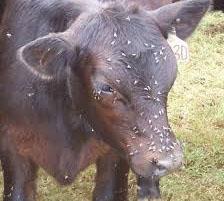Planning for Pasture Fly Control
By Dr. Lee Townsend
Here are a few things to consider as you weigh the options for pasture flies: face fly and horn fly control.
What is your key pest?
 A key pest is one that is there every year and, when it is bad, causes significant losses in reduced gains and extra expense in time and effort. In Kentucky it is usually either the horn fly or the face fly, and associated pink eye. Blood feeding by horn flies can reduce summer weight gains of young steers by 12 to 20 pounds. Face flies irritate animals as they lap up secretions around the eyes. It is hard to put a price on that, but face flies also can be a factor in the spread of pinkeye. These flies can spread the bacteria within a herd or move it from herd to herd.
A key pest is one that is there every year and, when it is bad, causes significant losses in reduced gains and extra expense in time and effort. In Kentucky it is usually either the horn fly or the face fly, and associated pink eye. Blood feeding by horn flies can reduce summer weight gains of young steers by 12 to 20 pounds. Face flies irritate animals as they lap up secretions around the eyes. It is hard to put a price on that, but face flies also can be a factor in the spread of pinkeye. These flies can spread the bacteria within a herd or move it from herd to herd.
Face flies and horn flies are around every herd in the state. Consider building your fly control program around the one that consistently causes the greater problem. While most fly control products and approaches are labeled for both pests, there are some differences in effectiveness.
The face fly is the more challenging pest because it spends very little time on animals. It feeds on the hard-to-treat face. In contrast, blood-feeding horn flies spend most all of their time on cattle, resting on the more easily treated sides and back of cattle.
Select the control strategy that puts the protection where it is needed. Also, consider grazing practices and pasture layout. If cattle are in pastures with controlled access to water and mineral, then forced-use or self-treatment options like dust bags, oilers, or automatic spray devices can be economical and effective.
Careful hanging of dust bags or suspending flyflips or other supplemental treatment devices to ensure treatment of the head and face can give very good face fly and horn fly control. Adjusting the nozzles on automatic sprayers will direct the liquid to the target most effectively. These self-application systems require some maintenance, and their insecticide dispensers have to be checked and refilled as needed.
If animals are moved regularly in a rotational grazing program, then fixed application stations may be less practical. Insecticidal ear tags provide a portable fly control system that moves with the animal. Tags tend to give very good horn fly control and a reduction in face fly numbers per head.
Spray or pour-on insecticides may be practical and very economical for horn fly control if there is a means of gathering up and confining/handling animals about once a month during the fly season.
Some like to feed mineral containing an insecticide. These feed-thru put insecticide in the cattle’s manure, the only breeding sites for horn flies and face flies. Most treatments are labeled only for horn fly control. Each animal must consume a minimum amount every day to keep the toxic level in manure. Horn flies can fly in from nearby herds so some form of supplemental control may be necessary.
Past performance
Were you satisfied with your fly control program in 2014? The satisfaction level can be difficult to judge. Face fly and horn fly populations are affected by general weather conditions, especially rainfall. Consequently, fly numbers on cattle can be due as much to weather conditions as product performance.
Resistance management
It’s important to consider your longterm insecticide use patterns. Continued use of insecticides with the same mode of action can lead to the development of pest populations that are more difficult to control. If you have been using pyrethroid ear tags for several consecutive years, incorporate insecticides with different modes of action into your program. Tags are available with insecticides having one of several ways of attacking the pest, and there are some combination tags that pair insecticides with different modes of action.
There are many options for pasture fly control. Matching products and application methods best suited for your key pest and herd management practices will help you pick an effective strategy.
Categories:
Spring
Animal Management


